當(dāng)前位置: Language Tips> 雙語(yǔ)新聞
The Fascinating Origins of 10 Beautiful Flower Names
分享到
大家都知道雛菊的英文名是daisy,但你知道它的含義嗎?Daisy來(lái)自于古英語(yǔ)短語(yǔ)d?gesege,表示“日之眼”。因?yàn)殡r菊黎明花開,黃昏花謝,好像生長(zhǎng)于天地之間的眼睛一樣。不過(guò),蘭花的英文名就沒(méi)有這么好聽了,不僅不優(yōu)雅,甚至名字還有點(diǎn)污。
1. CARNATION [kɑr'ne??n]
康乃馨

There are two etymologies for carnation, a term found in English in the early 1500s. According to one, carnation may be a corruption of coronation, perhaps because the flower’s toothed petals resembled crowns or because the flowers were worn, crown-like, as garlands. The second etymology comes from the flower’s original color, and roots carnation in the Middle French carnation, “pink complexion,” from the Latin root caro, “flesh,” source of less delicate words like carnal and carnage.
Carnation(康乃馨)在16世紀(jì)初期出現(xiàn)在英語(yǔ)中,關(guān)于carnation的詞源有兩種說(shuō)法。其中一種說(shuō)法認(rèn)為,carnation可能是coronation(加冕禮)的變體,因?yàn)榭的塑暗匿忼X狀花瓣好像皇冠,又或者是因?yàn)槿藗儼堰@種花當(dāng)花冠佩戴。第二種說(shuō)法與康乃馨的原色有關(guān),認(rèn)為carnation這個(gè)名字來(lái)自中古法語(yǔ)carnation(粉紅的氣色),這個(gè)單詞的拉丁語(yǔ)詞根是caro(肉欲),與carnal(肉欲的)、carnage(大屠殺)等不太好聽的單詞詞根相同。
2. CHRYSANTHEMUM [kr?'s?nθ?m?m]
菊花

The word chrysanthemum, emerging in English in the late 1500s, comes from the Greek krysanthemon, meaning “gold flower.” The first component, krysos (“gold”), shows up in the biological term chrysalis. The second, anthos (“flower”), appears in anthology, literally “a collection of flowers,” first used for a compilation of small poems in the early 1600s.
Chrysanthemum在16世紀(jì)末期傳入英語(yǔ),這個(gè)單詞源于希臘語(yǔ)krysanthemon(金色的花朵)。第一個(gè)組成部分krysos意為“金色的”,是形容蝶蛹的生物學(xué)術(shù)語(yǔ)。Anthos表示“花朵”,它也是anthology的詞根。Anthology意為 “鮮花大全”,在17世紀(jì)初期時(shí),這個(gè)單詞用來(lái)表示短詩(shī)集。
3. DAISY
雛菊
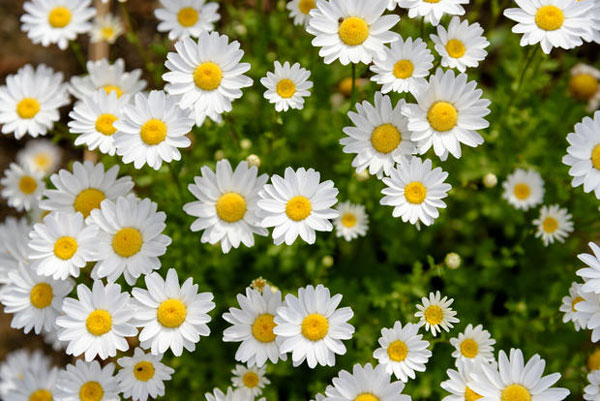
The word daisy has deep roots in the English language. As attested to in some of English’s earliest records, daisy comes from the Old English phrase d?gesege: the “day’s eye,” as the flower’s white petals close at dusk and open at dawn, like the eye of the day as it sleeps and wakes.
Daisy是一個(gè)地地道道的英語(yǔ)單詞。根據(jù)一些英語(yǔ)相關(guān)的早期記載,Daisy來(lái)自于古英語(yǔ)短語(yǔ)d?gesege,意思是“日之眼”。白色的雛菊黎明花開,黃昏花謝,就像是每一天的眼睛一樣睡去醒來(lái)。
4. ANEMONE [?'n?m?ni]
銀蓮花
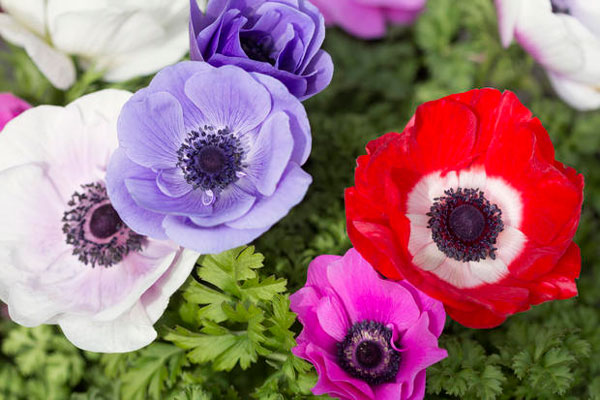
The anemone is also known as the windflower. Indeed, the word anemone, first attested in English in the mid-1500s, probably comes from a Greek word literally meaning “daughter of the wind.” It's said that the brightly colored petals of this flower only opened when the wind blew. Sea anemones took their names in the late 1700s on their likeness to the flowers.
Anemone(銀蓮花)也被稱為風(fēng)之花。事實(shí)上,anemone是在16世紀(jì)中葉首次出現(xiàn)在英語(yǔ)中的,它可能起源于一個(gè)希臘單詞,意思是“風(fēng)的女兒”。據(jù)說(shuō),明媚鮮艷的銀蓮花只有在風(fēng)吹過(guò)時(shí)才會(huì)綻放。因?yàn)殂y蓮花和海葵有幾分相似,到18世紀(jì)末期時(shí),人們將海葵(一種長(zhǎng)在水中的食肉動(dòng)物)稱為sea anemone。
5. FORGET-ME-NOT
勿忘我
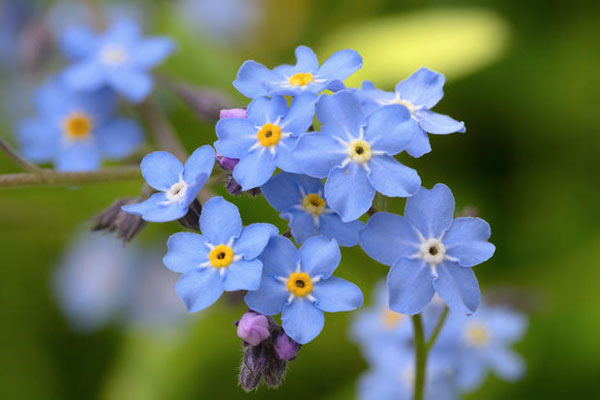
The name forget-me-not was a direct translation from the Old French ne m’oubliez mye (“do not forget me”). Renaissance romantics believed that, if they wore these soft-colored flowers, they would never be forgotten by their lovers, making the flower a symbol of fidelity and everlasting love.
勿忘我的英文名字forget-me-not直接翻譯自古法語(yǔ)“ne m’oubliez mye(勿忘我)”。文藝復(fù)興時(shí)期的浪漫主義者認(rèn)為,如果他們戴上這種色彩柔和的花朵,就永遠(yuǎn)不會(huì)被愛(ài)人遺忘。勿忘我因此成為忠誠(chéng)永恒愛(ài)情的象征。
6. ORCHID ['?rk?d]
蘭花
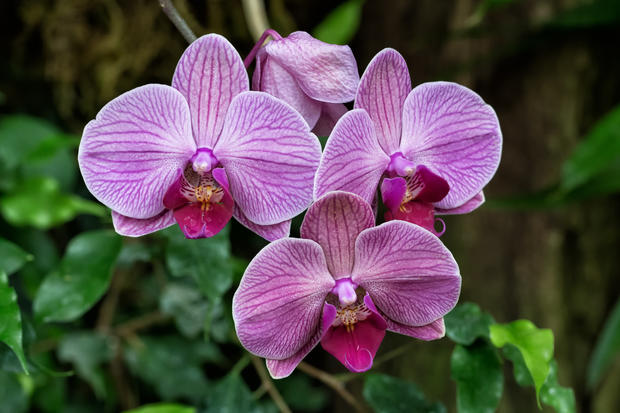
Orchids are a diverse family of extremely elegant flowers, but the literal meaning of their name, documented in English in the early 1840s, is a bit earthier, shall we say. Orchid comes from the Greek orkhis, meaning “testicle.” The flower's bulbous roots, often paired, have long been thought to resemble those male organs.
蘭科植物(orchid)都非常優(yōu)雅,但是它們的名字直譯過(guò)來(lái)卻有點(diǎn)粗俗。據(jù)記載,蘭花的英文名orchid出現(xiàn)在19世紀(jì)40年代。Orchid來(lái)自希臘語(yǔ)orkhis,也就是“睪丸”的意思。由于蘭花的球莖根通常是成對(duì)的,長(zhǎng)期以來(lái),人們一直認(rèn)為其和男性睪丸相似。
7. PEONY
牡丹
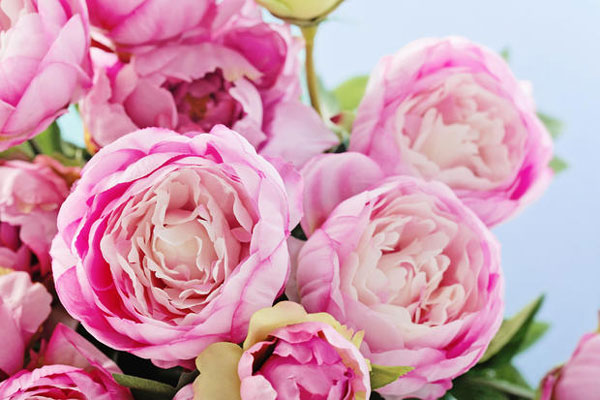
The peony, a word found in Old English, was believed to have healing properties in early medicine, which is why its name might honor Paion, the physician of the gods in Greek mythology.
牡丹的英文名peony起源于古英語(yǔ),在早期醫(yī)學(xué)中,人們認(rèn)為牡丹具有療傷功效,因此,可能根據(jù)希臘神話中眾神的醫(yī)生Paion,將其命名為peony。
8. RHODODENDRON [,rod?'d?ndr?n]
杜鵑

Like many other flower names, rhododendron enters the English record in the mid-1500s. The name literally means “rose tree” in Greek. It’s an apt name, for this shrub or small tree blooms with brilliant, rose-colored flowers.
和其他眾多鮮花名一樣,rhododendron(杜鵑)是16世紀(jì)中葉傳入英語(yǔ)中的。Rhododendron在希臘語(yǔ)中的意思是“玫瑰樹”。這個(gè)名字非常貼切,因?yàn)檫@種像小樹一樣的灌木植物能開出鮮艷的玫瑰色花朵。
9. TULIP
郁金香

Passing into English via Dutch or German in the late 1500s, tulip actually comes from the Turkishtülbent, based on the Persian dulband:“turban.” The flower, to its ancient namers, resembled the male headwear worn throughout the Middle East, India, and parts of Africa.
16世紀(jì)晚期,tulip(郁金香)從荷蘭語(yǔ)或德語(yǔ)中傳入英語(yǔ),這個(gè)單詞實(shí)際上源自于Turkishtülbent。Turkishtülbent來(lái)自于波斯語(yǔ)dulband,指“穆斯林的頭巾”。按照郁金香古代名字的意思,這種花好像中東、印度以及非洲部分地區(qū)男性的頭飾。
10. VIOLET
紫羅蘭
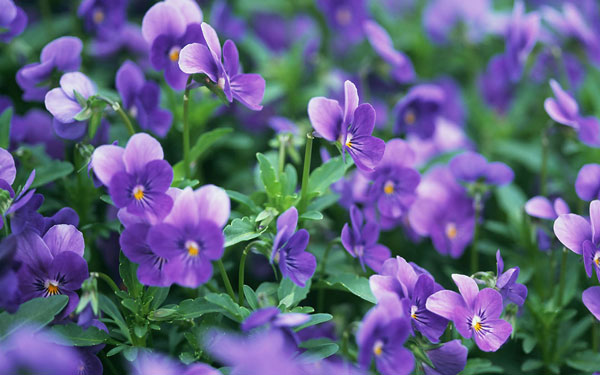
Before we had the color violet, recorded by the late 1300s, we had the flower violet, emerging some decades earlier in the same century. Violet grows out of the French violete or violette, a diminutive of viole, in turn the Latin viola, its name for this distinctively purple flower. This viola has no etymological relationship to the instrument. Some scholars suspect Latin got viola from the Greek name for the plant, ion.
據(jù)記載,在14世紀(jì)末期人們用violet表示紫羅蘭色,而再往前幾十年,也是在14世紀(jì),violet就指代紫羅蘭鮮花。Violet來(lái)自于法語(yǔ)中的 violete或violette,它們是viole的指小詞,而viole來(lái)自于拉丁語(yǔ)單詞 viola,也就是拉丁語(yǔ)中對(duì)這種獨(dú)特的紫色花朵的稱呼。拉丁文viola(英語(yǔ)中有中提琴的意思)和中提琴毫無(wú)關(guān)系。一些學(xué)者認(rèn)為,它來(lái)自于希臘語(yǔ)中對(duì)紫羅蘭的稱呼 ion。
英文來(lái)源:mentalfloss.com
翻譯&編輯:董靜
審校:yaning
上一篇 : 沙特人終于可以進(jìn)電影院了!
下一篇 :
分享到
關(guān)注和訂閱

口語(yǔ)
關(guān)于我們 | 聯(lián)系方式 | 招聘信息
電話:8610-84883645
傳真:8610-84883500
Email: languagetips@chinadaily.com.cn